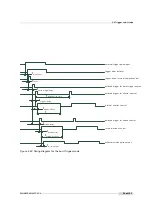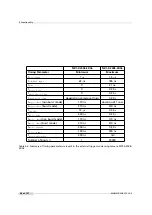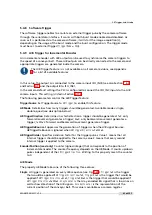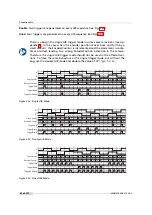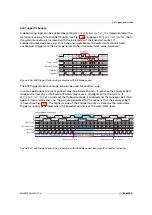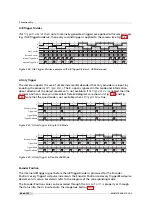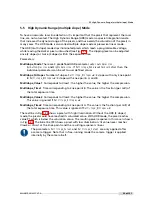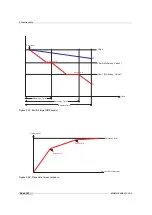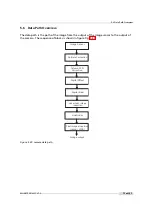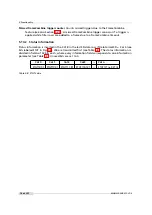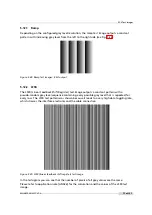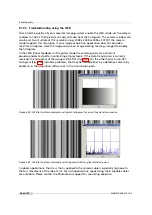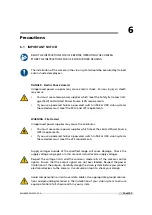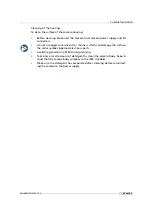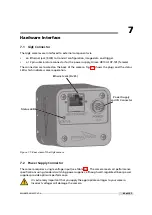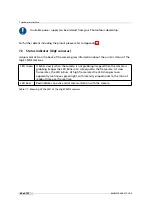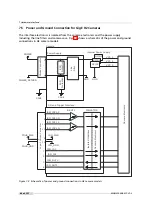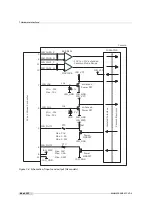
5.9 Gain and Offset
5.9
Gain and Offset
There are three different gain settings on the camera:
Analog Gain
Analog gain on the image sensor (only available in some models, see Appendix
B). Available values: x1, x1.2, x1.4, x1.6. Note that
Digital Offset
is applied after the
Analog Gain
.
Gain (Digital Fine Gain)
Digital fine gain accepts fractional values from 0.01 up to 15.99. It is
implemented as a multiplication operation. Colour camera models only: There is
additionally a gain for every RGB colour channel. The RGB channel gain is used to
calibrate the white balance in an image, which has to be set according to the current
lighting condition.
Digital Gain
Digital Gain is a coarse gain with the settings x1, x2, x4 and x8. It is implemented
as a binary shift of the image data where ’0’ is shifted to the LSB’s of the gray values. E.g.
for gain x2, the output value is shifted by 1 and bit 0 is set to ’0’.
The resulting gain is the product of the three gain values, which means that the image data is
multiplied in the camera by this factor.
Digital Fine Gain and Digital Gain may result in missing codes in the output im-
age data.
A user-defined value can be subtracted from the gray value in the digital offset block. If digital
gain is applied and if the brightness of the image is too big then the interesting part of the
output image might be saturated. By subtracting an offset from the input of the gain block it
is possible to avoid the saturation.
5.10
Image Information and Status Information
There are camera properties available that give information about the acquired images, such
as an image counter and the number of missed trigger signals. These properties can be queried
by software.
5.10.1
Counters
Image counter
The image counter provides a sequential number of every image that is output.
After camera startup, the counter counts up from 0 (counter width 24 bit). The counter
can be reset by the camera control software.
Real Time counter (Time stamp)
The time counter starts at 0 after camera start, and counts
real-time in units of 1 micro-second. The time counter can be reset by the software in the
SDK (Counter width 32 bit).
Missed trigger counter
The missed trigger counter counts trigger pulses that were ignored by
the camera because they occurred within the exposure or read-out time of an image. In
free-running mode it counts all incoming external triggers (counter width 8 bit / no wrap
around).
Missed burst trigger counter
The missed burst trigger counter counts trigger pulses that were
ignored by the camera in the burst trigger mode because they occurred while the camera
still was processing the current burst trigger sequence.
MAN075 05/2017 V1.0
73 of 127
Summary of Contents for MV1-D2048-3D06 series
Page 10: ...1 Preface 10 of 127 MAN075 05 2017 V1 0...
Page 12: ...2 Introduction 12 of 127 MAN075 05 2017 V1 0...
Page 26: ...3 How to get started 3D GigE G2 26 of 127 MAN075 05 2017 V1 0...
Page 32: ...4 Product Specification 32 of 127 MAN075 05 2017 V1 0...
Page 66: ...5 Functionality 66 of 127 MAN075 05 2017 V1 0...
Page 82: ...6 Precautions 82 of 127 MAN075 05 2017 V1 0...
Page 120: ...12 Support and Repair 120 of 127 MAN075 05 2017 V1 0...
Page 122: ...13 References 122 of 127 MAN075 05 2017 V1 0...

